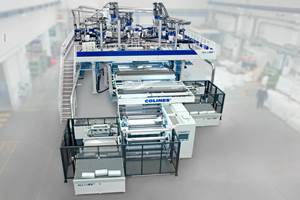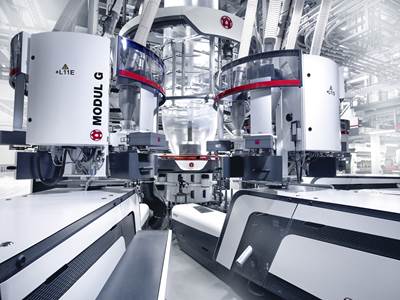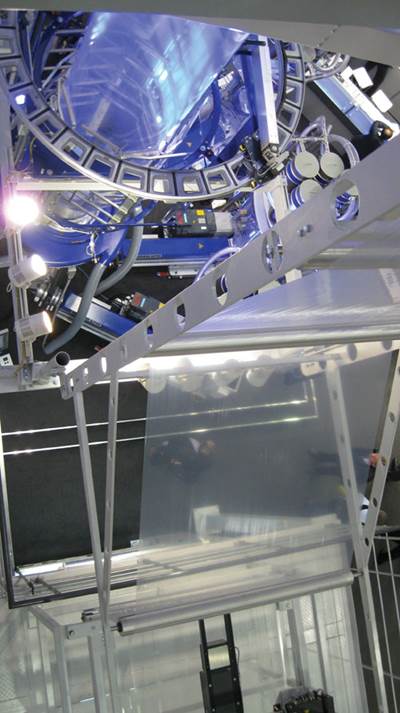There’s nothing small about ProAmpac. Headquartered in Cincinnati, the company was founded in 1971 as Jen-Coat Inc. It changed its name to Prolamina in 2011, and since then has made a whopping 16 acquisitions to expand its product, end-market and global footprints.
Today, ProAmpac—this name came about when Prolamina merged with Ampac Packaging in August 2015—has 41 manufacturing plants globally, with more than 5200 employees, and supplies more than 5500 customers in 90 countries. Its vast product line of films, adhesive/extrusion laminations, paper delivery bags, barrier and non-barrier structures, pouch and bag making, both paper and poly mailers, lidding, flexographic and rotogravure printing, prototyping and more, reflects what the company calls “very, very dynamic innovation” in materials, design, printing and production, which includes risk-mitigating, high volume, and redundant manufacturing. If weather cuts out a ProAmpac plant in one region, another facility is brought online, keeping the customer’s supply chain undisturbed.
The company leads the flexible-packaging industry in the scope of rollstock, bags and pouches offered, specifically for packaging pet food, one of its core markets. It’s also a major player in the lawn and garden market, supplying customers like Scotts Miracle Gro; food packaging, where its customers include the likes of Hormel; as well as the health and beauty market, where it supports L’Oréal. It also supplies packaging to many smaller private-label brands, and has a strong footprint in packaging for beverage, home, e-commerce, food service and drug delivery. Concerning the latter, ProAmpac is the North American market leader in drug-delivery pharmaceutical barrier packaging.
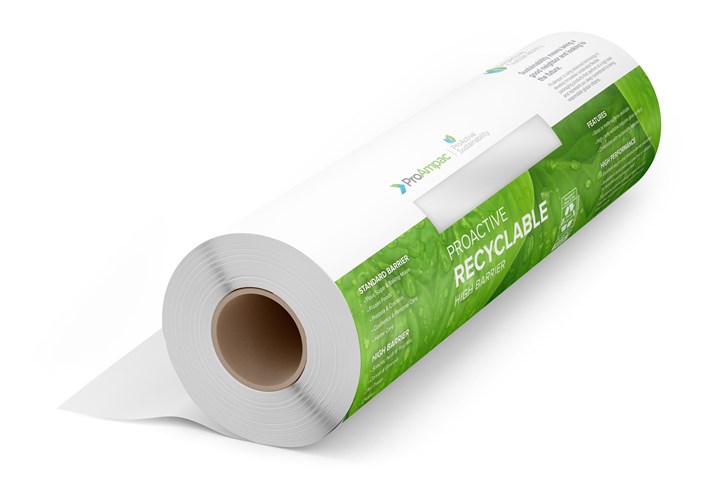
“Every product we make at ProAmpac is custom, whether it’s one layer or 10 layers,” says Greg Tucker, ProAmpac founder and CEO. “It’s all customized to run on the customer’s line, to accommodate their graphics. And we’re substrate agnostic,” meaning ProAmpac draws from a range of paper and polymer materials, and today increasingly from materials with advanced sustainability characteristics.
“Every product we make at ProAmpac is custom, whether it’s one layer or 10 layers.”
Yet despite all this firepower, ProAmpac operates like a fast and feisty small company eager to bring solutions to brand owners large and small. This reflects the philosophy of Tucker, who joined Prolamina as CEO in 2012 and led the merger with Ampac three years later.
Shortly after the 2015 merger with Ampac, Tucker said to employees, “Within this new company, I want to foster a culture of boundaryless behavior. That means a workplace where people are not concerned about organizational lines, politics, or bureaucracy, but instead people work with speed, simplicity, and self-confidence to accomplish our goals. Acting with the four core values of integrity, intensity, innovation and involvement will create a high-functioning team where its members are more concerned with the success of their teammates than their own.”
Today, Tucker says, that script has not changed. “Our culture is to care more about your teammates than yourself,” he says. When it comes to competing, the CEO urges his people to “think big, but act small.”
Adds Sal Pellingra, ProAmpac’s v.p. of global innovation and technology, “We have a small-company mentality. Our customers have direct access and support for innovation, ideation and prototyping. We can turn around samples in days to support new projects. We pre-qualify materials on the same kind of machines they use in production to get it right the first time. From a service standpoint, while it might sound cliché, we do collaborate, we really are a partner. And we feel if you create a culture of innovation and collaboration, the customer will come to you first.”
Pellingra adds, “We had one case where we had a field-service engineer at a customer’s plant for two days to make sure the product we supplied ran the way we said it would. The feedback we got was, ‘We can’t even get some of your competitors on a Zoom call for a few minutes, and here you are in person for two days.’”
Tucker puts it like this, “At ProAmpac, our culture is key to our long-term success. We strive to be authentic as we live out the heritage of our small-business culture. We value the connections we’ve created, and our employees feel empowered in their shared efforts to innovate successfully. ProAmpac was founded on the idea that a focus on material science will drive innovative and sustainable solutions for our customers, supported by our four core values that foster a culture of speed, simplicity, and self-confidence. Our company is made stronger by challenging ourselves and each other, while we move what matters forward. With a focus on performance and a passion for our work, we are not bound by organizational hierarchy. We are committed to serving our customers and the communities in which we work and live.”
“We strive to be authentic as we live out the heritage of our small-business culture.”
After the Ampac merger, Tucker spearheaded acquisitions of a dozen more specialty packaging businesses, invested significantly in new equipment, and built step-by-step an executive leadership base, which he describes as the critical foundation of the company. In October 2016, ProAmpac was acquired by Pritzker Private Capital. Says Tucker, “In partnering with Pritzker we achieved longer-term capital investment as well as a partnership with a group who hold common values.”
Sustainable Solutions
In line with virtually every brand owner, customer, retailer, and the flexible packaging industry itself, sustainability remains a top priority at ProAmpac. “We have branded our focus as ProActive Sustainability,” says chief commercial officer Adam Grose. This means reducing waste and energy and water usage as well as stewardship over the environmental impact of its facilities, he says.
It includes research and development of flexible packaging in the five ProActive Sustainability product categories: recyclable, recycle-ready; renewable, compostable, and post-consumer recycled (PCR) materials.
“Flexible packaging itself offers sustainability advantages when compared with rigid packaging,” Grose says.
As Grose sees it, these benefits include using less virgin plastic; getting more product out of the package, reducing waste; portability and easy storage; e-commerce friendly; reduction in void fill and secondary packaging; reduced breakage; reduced environmental impact in production by using less energy and fewer natural resources; and, in transportation, requiring fewer trucks, using less fuel.
Under the ProActive Sustainability name, ProAmpac developed a suite of sustainable product groups. These include:
• ProActive Recyclable films, which are considered recycle-ready structures, pre-qualified for in-store drop-off in North America.
• ProActive Compostable, the company’s biodegradable solution, compliant with ASTM D6400/6868 standard for industrial compostability. (Under ISO Standard EN13432, compostability testing must be completed on the final package to be considered compliant.)
• ProActive PCR, which integrates recycled materials in the overall structure to meet a variety of standard and high-barrier rollstock and pouch applications.
• ProActive Renewable film, which utilizes plant-based PE to reduce carbon footprint.
To accommodate customers who want to replace their traditional processes with a near-seamless integration of sustainable packaging alternatives, ProAmpac has created “run-at-rate” recyclable and PCR structures. Notes ProAmpac customer Nigel Hargreaves, sales director of WestLab, a manufacturer of mineral salts, “ProAmpac’s film is not only recyclable, but it ran at-rate on our filling machines.” His firm is using ProActive Recyclable R-1050. It is one of six recyclable films for vertical and horizontal form-film-seal (FFS) and flow-wrap packaging applications.
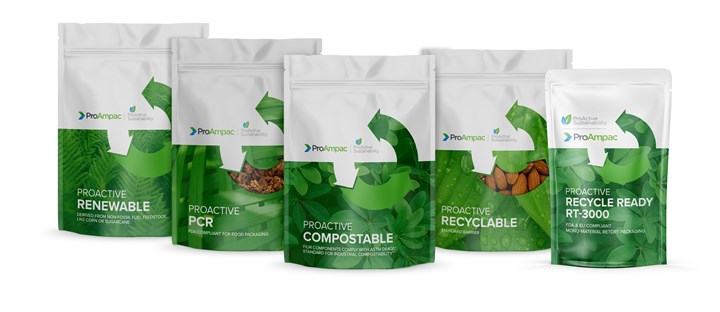
ProAmpac is a member of The Association of Plastic Recyclers, a trade association representing companies responsible for more than 90% of the post-consumer plastics processing capacity in North America. It belongs to CEFLEX, a consortium of more than 100 flexible-packaging companies and associations seeking circular-economy solutions in Europe. ProAmpac’s commitments include 4Ocean and Planet Water Foundation; and its Wrightstown, Wis., facility has been designated “Green Professional” by the Green Master’s Program, a recognition, assessment and certification program for Wisconsin businesses’ sustainability initiatives.
Culture of Innovation
This summer ProAmpac plans to open its Collaboration & Innovation Center (CIC). The 35,000 ft2 facility is under construction in Rochester, N.Y. The CIC is an expansion of the company’s Rochester manufacturing facility and can produce one or more prototypes or shift to a production run in the millions, says Pellingra, a 15-yr veteran of ProAmpac who before that worked at the BOPP films business of Mobil (now Jindal). He is multi-lingual and quips that he speaks “English and packaging.” He is the holder of 25 patents and teaches a packaging course at the University of Cincinnati.
The CIC will become home base for ProAmpac’s Design and Sample Lab (DASL) and will play an important role in accelerating product development, application and end-use testing, and analytical, shelf-stability and distribution testing. It will also provide space for meetings with customers and vendors, and for training.
At ProAmpac, innovation ranges from everyday tweaks to making a pouch run better on a customer’s high-speed FFS equipment to development of a radical new flexible-packaging structure that replaces rigid containers with improved functionality and sustainable materials.
ProAmpac has coined the term “Collaborative Innovation” to identify an accelerated approach through which it pairs its own product-development (PD) teams with the customer’s PD group. “We can turn around any pouch prototype with or without graphics within days, in any shape, any form and size, so customers touch it and experience it,” says Pellingra. “These capabilities are always important but are particularly critical now when lots of brand owners are short-handed, overtaxed and need to reach out and lean on external resources.”
ProAmpac is centralizing its physical and analytical lab in Rochester instead of distributing these capabilities among various production sites in an effort, Pellingra says, to “let our manufacturing sites focus on manufacturing.” Rochester will be equipped with vertical and horizontal FFS machines, “So we can make sure our films are tested in a production environment and can be run without sacrificing speed before we get them to the customer.”
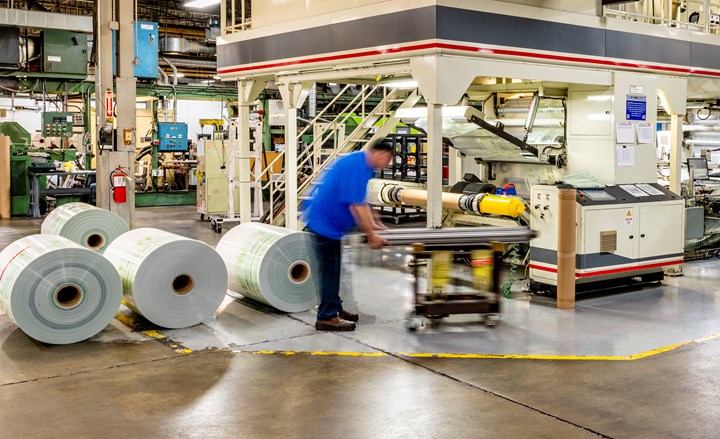
At ProAmpac, Collaborative Innovation is a multi-pronged approach consisting of:
• IDEA, a disciplined, two-day collaborative process available to help customers generate packaging ideas and bring them to life in a tangible plan for execution.
• DASL, a project-engagement service that helps customers conceive, illustrate, render, and prototype new packaging. DASL provides support for samples, small-quantity orders, and rapid prototyping.
• MAKR, the company’s online packaging-design configurator that allows users to remotely create custom 3D package designs in both film and paper formats, which can then be prototyped at the DASL.
• ProAmpac’s ProActive CHART is a life-cycle-analysis process that helps customers evaluate packaging alternatives and their impact on the environment.
• Materials Science Research, whereby university researchers support ProAmpac’s internal teams. ProAmpac has an R&D alliance with Polytechnique Montréal. The university’s “Sustainable, Safe and Smart Polymer Flexible Packaging” program includes 13 PhDs who support ProAmpac’s R&D. Last April, the alliance was extended for another five years. It will provide ProAmpac world-class analytical and research support for its product-development and support activities.
Some of the focus areas the university and ProAmpac are working on include “smart “packaging technology for food safety and sustainability, including biobased and compostable/biodegradable materials.
In February 2021, ProAmpac announced a partnership with Clemson University’s Dept. of Food, Nutrition and Packaging Sciences that will support the company’s commitment to leading the industry in developing smart food packaging. ProAmpac is working with Clemson’s Kay Cooksey, professor and Cryovac Endowed Chair of the department, which is within the College of Agriculture, Forestry and Life Sciences. This University support is being integrated with ProAmpac’s Product Development and Innovation teams.
All this focus on innovation has reaped rewards, Pellingra notes. ProAmpac recently worked with Ocean Spray to develop a mono-material, multi-layer drinking pouch that includes an HDPE outer layer for stiffness that was modified to improve clarity. ProAmpac is also working with brand owners on package designs specific to e-commerce applications, which generally have involved switching from rigid to flexible structures. Soon to be commercialized is a quad-style pouch for a food-related dry product that allows the brand owner to maximize its allotted shelf space in stores.
States Pellingra, “I talk with brand owners every day. Our approach has always been proactive. We are in a position to say, ‘Here is what you have today. Here are the trends we see. If you were to start out today, based on where the market is going, here is a format we think you should use. Here is what you can do in the next six to nine months, here is what you can do in the next 15-24 months, here is what you can do farther out.’ It’s helping brand owners build a path to their strategic and sustainable product goals.”
Related Content
ABC Technologies to Acquire Windsor Mold Group Technologies
The Tier One automotive supplier with compounding and blowmolding machine capabilities adds the 50-yr-old molder and moldmaker.
Read MoreYoung Stretch-Film Processor Bets on Nanolayers
Going up against companies with as much as double its capacity, young stretch-film processor Zummit believes that new technology — notably 59-nanolayer films — will give it a competitive edge.
Read MoreHow to Optimize Injection Molding of PHA and PHA/PLA Blends
Here are processing guidelines aimed at both getting the PHA resin into the process without degrading it, and reducing residence time at melt temperatures.
Read MoreFormulating LLDPE/LDPE Blends For Abuse–Resistant Blown Film
A new study shows how the type and amount of LDPE in blends with LLDPE affect the processing and strength/toughness properties of blown film. Data are shown for both LDPE-rich and LLDPE-rich blends.
Read MoreRead Next
PE Film Market Snapshot 2020: Converter Film
Market pegged to grow 5.7% yearly through 2022.
Read MoreTips and Techniques: How to Downgauge Film Without Losing the ‘Feel’ of Quality
These days, blown film processors supplying converters and packagers with high-end materials are between a rock and a hard place.
Read MoreFilm Processor Launches First-Ever Mobile App for the Flexible Packaging Industry
Calculating, converting, and planning is now easier and faster than with new app from Polykar.
Read More


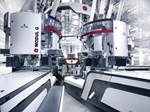







.png;maxWidth=300;quality=90)














